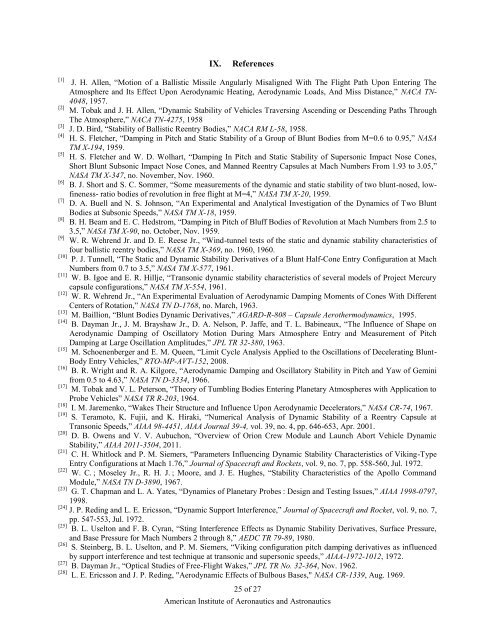Survey of Blunt Body Dynamic Stability in Supersonic Flow
Survey of Blunt Body Dynamic Stability in Supersonic Flow
Survey of Blunt Body Dynamic Stability in Supersonic Flow
Create successful ePaper yourself
Turn your PDF publications into a flip-book with our unique Google optimized e-Paper software.
IX.<br />
References<br />
[1]<br />
J. H. Allen, “Motion <strong>of</strong> a Ballistic Missile Angularly Misaligned With The Flight Path Upon Enter<strong>in</strong>g The<br />
Atmosphere and Its Effect Upon Aerodynamic Heat<strong>in</strong>g, Aerodynamic Loads, And Miss Distance,” NACA TN-<br />
4048, 1957.<br />
[2]<br />
M. Tobak and J. H. Allen, “<strong>Dynamic</strong> <strong>Stability</strong> <strong>of</strong> Vehicles Travers<strong>in</strong>g Ascend<strong>in</strong>g or Descend<strong>in</strong>g Paths Through<br />
The Atmosphere,” NACA TN-4275, 1958<br />
[3]<br />
J. D. Bird, “<strong>Stability</strong> <strong>of</strong> Ballistic Reentry Bodies,” NACA RM L-58, 1958.<br />
[4]<br />
H. S. Fletcher, “Damp<strong>in</strong>g <strong>in</strong> Pitch and Static <strong>Stability</strong> <strong>of</strong> a Group <strong>of</strong> <strong>Blunt</strong> Bodies from M=0.6 to 0.95,” NASA<br />
TM X-194, 1959.<br />
[5]<br />
H. S. Fletcher and W. D. Wolhart, “Damp<strong>in</strong>g In Pitch and Static <strong>Stability</strong> <strong>of</strong> <strong>Supersonic</strong> Impact Nose Cones,<br />
Short <strong>Blunt</strong> Subsonic Impact Nose Cones, and Manned Reentry Capsules at Mach Numbers From 1.93 to 3.05,”<br />
NASA TM X-347, no. November, Nov. 1960.<br />
[6]<br />
B. J. Short and S. C. Sommer, “Some measurements <strong>of</strong> the dynamic and static stability <strong>of</strong> two blunt-nosed, lowf<strong>in</strong>eness-<br />
ratio bodies <strong>of</strong> revolution <strong>in</strong> free flight at M=4,” NASA TM X-20, 1959.<br />
[7]<br />
D. A. Buell and N. S. Johnson, “An Experimental and Analytical Investigation <strong>of</strong> the <strong>Dynamic</strong>s <strong>of</strong> Two <strong>Blunt</strong><br />
Bodies at Subsonic Speeds,” NASA TM X-18, 1959.<br />
[8]<br />
B. H. Beam and E. C. Hedstrom, “Damp<strong>in</strong>g <strong>in</strong> Pitch <strong>of</strong> Bluff Bodies <strong>of</strong> Revolution at Mach Numbers from 2.5 to<br />
3.5,” NASA TM X-90, no. October, Nov. 1959.<br />
[9]<br />
W. R. Wehrend Jr. and D. E. Reese Jr., “W<strong>in</strong>d-tunnel tests <strong>of</strong> the static and dynamic stability characteristics <strong>of</strong><br />
four ballistic reentry bodies,” NASA TM X-369, no. 1960, 1960.<br />
[10]<br />
P. J. Tunnell, “The Static and <strong>Dynamic</strong> <strong>Stability</strong> Derivatives <strong>of</strong> a <strong>Blunt</strong> Half-Cone Entry Configuration at Mach<br />
Numbers from 0.7 to 3.5,” NASA TM X-577, 1961.<br />
[11]<br />
W. B. Igoe and E. R. Hillje, “Transonic dynamic stability characteristics <strong>of</strong> several models <strong>of</strong> Project Mercury<br />
capsule configurations,” NASA TM X-554, 1961.<br />
[12]<br />
W. R. Wehrend Jr., “An Experimental Evaluation <strong>of</strong> Aerodynamic Damp<strong>in</strong>g Moments <strong>of</strong> Cones With Different<br />
Centers <strong>of</strong> Rotation,” NASA TN D-1768, no. March, 1963.<br />
[13]<br />
M. Baillion, “<strong>Blunt</strong> Bodies <strong>Dynamic</strong> Derivatives,” AGARD-R-808 – Capsule Aerothermodynamics, 1995.<br />
[14]<br />
B. Dayman Jr., J. M. Brayshaw Jr., D. A. Nelson, P. Jaffe, and T. L. Bab<strong>in</strong>eaux, “The Influence <strong>of</strong> Shape on<br />
Aerodynamic Damp<strong>in</strong>g <strong>of</strong> Oscillatory Motion Dur<strong>in</strong>g Mars Atmosphere Entry and Measurement <strong>of</strong> Pitch<br />
Damp<strong>in</strong>g at Large Oscillation Amplitudes,” JPL TR 32-380, 1963.<br />
[15]<br />
M. Schoenenberger and E. M. Queen, “Limit Cycle Analysis Applied to the Oscillations <strong>of</strong> Decelerat<strong>in</strong>g <strong>Blunt</strong>-<br />
<strong>Body</strong> Entry Vehicles,” RTO-MP-AVT-152, 2008.<br />
[16]<br />
B. R. Wright and R. A. Kilgore, “Aerodynamic Damp<strong>in</strong>g and Oscillatory <strong>Stability</strong> <strong>in</strong> Pitch and Yaw <strong>of</strong> Gem<strong>in</strong>i<br />
from 0.5 to 4.63,” NASA TN D-3334, 1966.<br />
[17]<br />
M. Tobak and V. L. Peterson, “Theory <strong>of</strong> Tumbl<strong>in</strong>g Bodies Enter<strong>in</strong>g Planetary Atmospheres with Application to<br />
Probe Vehicles” NASA TR R-203, 1964.<br />
[18]<br />
I. M. Jaremenko, “Wakes Their Structure and Influence Upon Aerodynamic Decelerators,” NASA CR-74, 1967.<br />
[19]<br />
S. Teramoto, K. Fujii, and K. Hiraki, “Numerical Analysis <strong>of</strong> <strong>Dynamic</strong> <strong>Stability</strong> <strong>of</strong> a Reentry Capsule at<br />
Transonic Speeds,” AIAA 98-4451, AIAA Journal 39-4, vol. 39, no. 4, pp. 646-653, Apr. 2001.<br />
[20]<br />
D. B. Owens and V. V. Aubuchon, “Overview <strong>of</strong> Orion Crew Module and Launch Abort Vehicle <strong>Dynamic</strong><br />
<strong>Stability</strong>,” AIAA 2011-3504, 2011.<br />
[21]<br />
C. H. Whitlock and P. M. Siemers, “Parameters Influenc<strong>in</strong>g <strong>Dynamic</strong> <strong>Stability</strong> Characteristics <strong>of</strong> Vik<strong>in</strong>g-Type<br />
Entry Configurations at Mach 1.76,” Journal <strong>of</strong> Spacecraft and Rockets, vol. 9, no. 7, pp. 558-560, Jul. 1972.<br />
[22]<br />
W. C. ; Moseley Jr., R. H. J. ; Moore, and J. E. Hughes, “<strong>Stability</strong> Characteristics <strong>of</strong> the Apollo Command<br />
Module,” NASA TN D-3890, 1967.<br />
[23]<br />
G. T. Chapman and L. A. Yates, “<strong>Dynamic</strong>s <strong>of</strong> Planetary Probes : Design and Test<strong>in</strong>g Issues,” AIAA 1998-0797,<br />
1998.<br />
[24] J. P. Red<strong>in</strong>g and L. E. Ericsson, “<strong>Dynamic</strong> Support Interference,” Journal <strong>of</strong> Spacecraft and Rocket, vol. 9, no. 7,<br />
pp. 547-553, Jul. 1972.<br />
[25]<br />
B. L. Uselton and F. B. Cyran, “St<strong>in</strong>g Interference Effects as <strong>Dynamic</strong> <strong>Stability</strong> Derivatives, Surface Pressure,<br />
and Base Pressure for Mach Numbers 2 through 8,” AEDC TR 79-89, 1980.<br />
[26]<br />
S. Ste<strong>in</strong>berg, B. L. Uselton, and P. M. Siemers, “Vik<strong>in</strong>g configuration pitch damp<strong>in</strong>g derivatives as <strong>in</strong>fluenced<br />
by support <strong>in</strong>terference and test technique at transonic and supersonic speeds,” AIAA-1972-1012, 1972.<br />
[27]<br />
B. Dayman Jr., “Optical Studies <strong>of</strong> Free-Flight Wakes,” JPL TR No. 32-364, Nov. 1962.<br />
[28]<br />
L. E. Ericsson and J. P. Red<strong>in</strong>g, "Aerodynamic Effects <strong>of</strong> Bulbous Bases," NASA CR-1339, Aug. 1969.<br />
25 <strong>of</strong> 27<br />
American Institute <strong>of</strong> Aeronautics and Astronautics
















